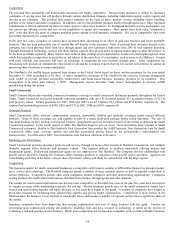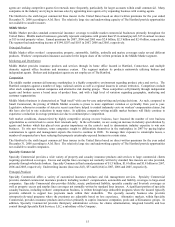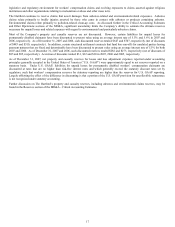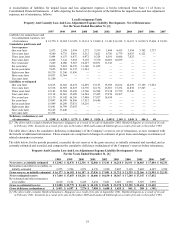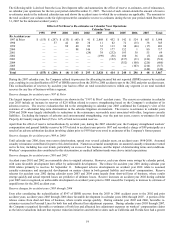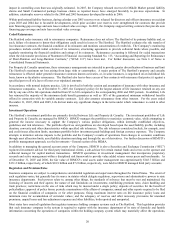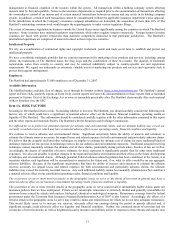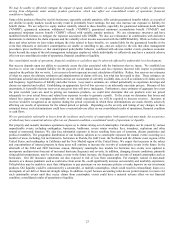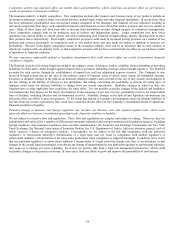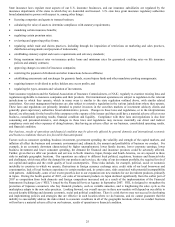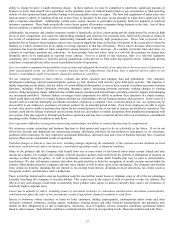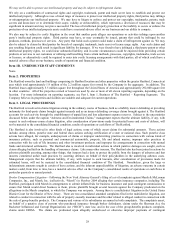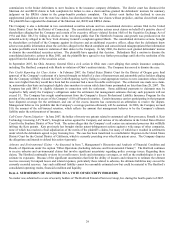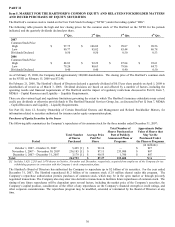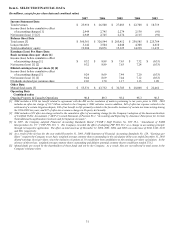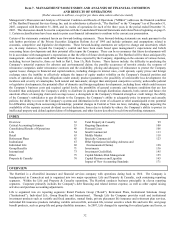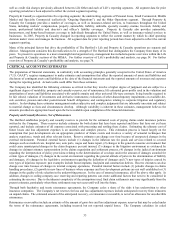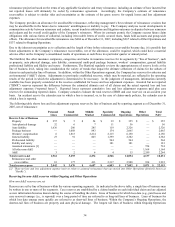The Hartford 2007 Annual Report Download - page 24
Download and view the complete annual report
Please find page 24 of the 2007 The Hartford annual report below. You can navigate through the pages in the report by either clicking on the pages listed below, or by using the keyword search tool below to find specific information within the annual report.24
Competitive activity may adversely affect our market share and profitability, which could have an adverse effect on our business,
results of operations or financial condition.
The insurance industry is highly competitive. Our competitors include other insurers and, because many of our products include an
investment component, securities firms, investment advisers, mutual funds, banks and other financial institutions. In recent years, there
has been substantial consolidation and convergence among companies in the insurance and financial services industries resulting in
increased competition from large, well-capitalized insurance and financial services firms that market products and services similar to
ours. Many of these firms also have been able to increase their distribution systems through mergers or contractual arrangements.
These competitors compete with us for producers such as brokers and independent agents. Larger competitors may have lower
operating costs and an ability to absorb greater risk while maintaining their financial strength ratings, thereby allowing them to price
their products more competitively. These highly competitive pressures could result in increased pricing pressures on a number of our
products and services, particularly as competitors seek to win market share, and may harm our ability to maintain or increase our
profitability. Because of the highly competitive nature of the insurance industry, there can be no assurance that we will continue to
effectively compete with our industry rivals, or that competitive pressure will not have a material adverse effect on our business, results
of operations or financial condition.
We may experience unfavorable judicial or legislative developments that could adversely affect our results of operations, financial
condition or liquidity.
The Hartford is involved in claims litigation arising in the ordinary course of business, both as a liability insurer defending or providing
indemnity for third-party claims brought against insureds and as an insurer defending coverage claims brought against it. The Hartford
accounts for such activity through the establishment of unpaid loss and loss adjustment expense reserves. The Company is also
involved in legal actions that do not arise in the ordinary course of business, some of which assert claims for substantial amounts.
Pervasive or dramatic changes in the judicial environment relating to matters such as trends in the size of jury awards, developments in
the law relating to the liability of insurers or tort defendants, and rulings concerning the availability or amount of certain types of
damages could cause our ultimate liabilities to change from our current expectations. Similarly, changes in federal or state tort
litigation laws or other applicable laws could have the same effect. It is not possible to predict changes in the judicial and legislative
environment and their impact on the future development of the adequacy of our loss reserves, particularly reserves for longer-tailed
lines of business, including asbestos and environmental reserves. Similarly, changes in the judicial and legislative environment can
adversely affect our ability to price our products. To the extent that judicial or legislative developments cause our ultimate liabilities to
increase from our current expectations, they could have a material adverse effect on the Company’ s consolidated results of operations,
financial condition or liquidity.
Potential changes in domestic and foreign regulation may increase our business costs and required capital levels, which could
adversely affect our business, consolidated operating results, financial condition or liquidity.
We are subject to extensive laws and regulations. These laws and regulations are complex and subject to change. Moreover, they are
administered and enforced by a number of different governmental authorities and non-governmental self-regulatory agencies, including
foreign regulators, state insurance regulators, state securities administrators, the Securities and Exchange Commission, the New York
Stock Exchange, the National Association of Securities Dealers, the U.S. Department of Justice, and state attorneys general, each of
which exercises a degree of interpretive latitude. Consequently, we are subject to the risk that compliance with any particular
regulator’ s or enforcement authority’ s interpretation of a legal issue may not result in compliance with another regulator’ s or
enforcement authority’ s interpretation of the same issue, particularly when compliance is judged in hindsight. In addition, there is risk
that any particular regulator’ s or enforcement authority’ s interpretation of a legal issue may change over time to our detriment, or that
changes in the overall legal environment, even absent any change of interpretation by any particular regulator or enforcement authority,
may cause us to change our views regarding the actions we need to take from a legal risk management perspective, which could
necessitate changes to our practices that may, in some cases, limit our ability to grow and improve the profitability of our business.


